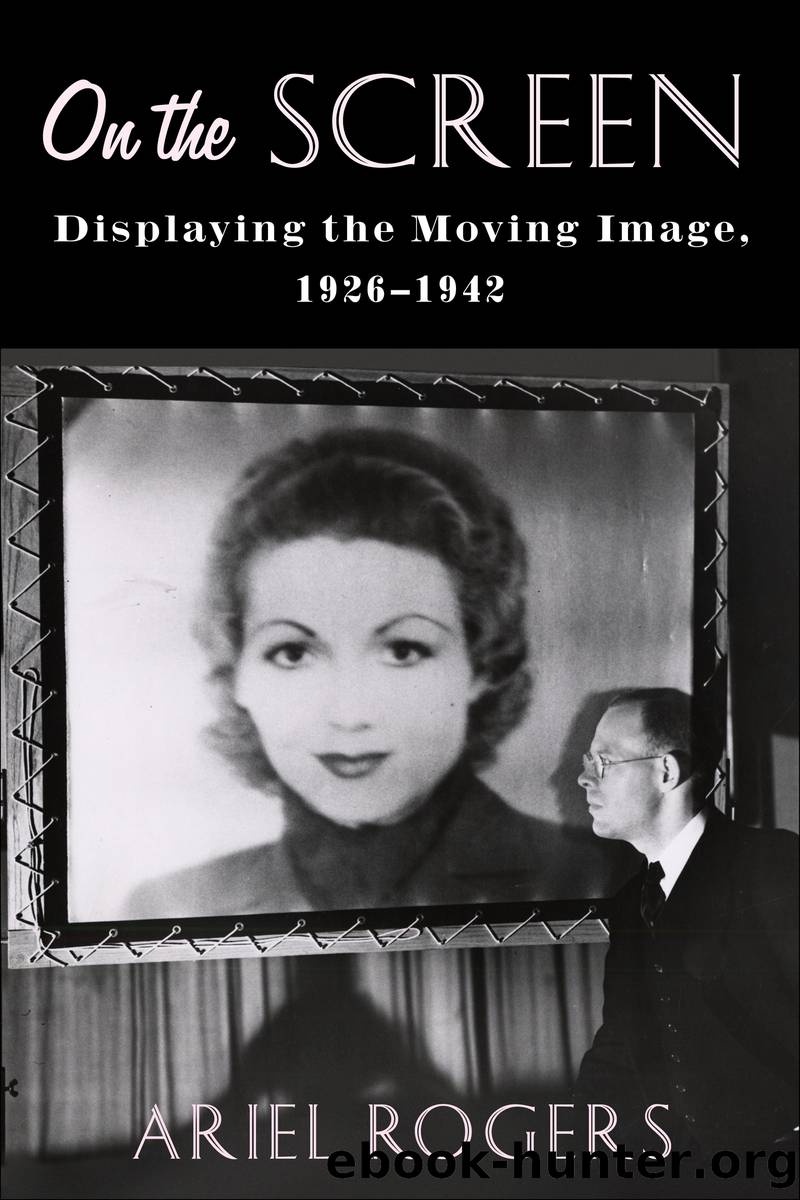On the Screen by Rogers Ariel;

Author:Rogers, Ariel;
Language: eng
Format: epub
Publisher: Lightning Source Inc. (Tier 3)
4.8 The Automotion Pictures, Inc., double-purpose projector allowed for both straight projection onto a large screen and rear projection onto a small, attached screen.
Source: Movie Makers, October 1935, 416.
Both portable and more-permanent screen installations were also being utilized in department stores and expositions. In such cases, the screens themselves could be moveable, and they were also employed to guide the movement of viewers.133 Not only did department stores offer forms of visual display that aligned in certain ways with cinema, but they served as long-standing sites for the presentation of moving images and the demonstration of moving-image technologies.134 In 1938, in a section on the use of motion pictures in the department store, the inaugural issue of Business Screen suggested that movies be used in this context not simply as attractions in their own right but also as a way to train employees and appeal to customers. In addition to constructing dedicated theaters for this purpose, department stores, it was advised, could integrate portable projection units into the building’s walls, install them on department counters, and place them in the store windows. It was emphasized, moreover, that the placement of such displays was important since they should work not only to attract crowds but also to “draw customers through departments featured on the program.”135 A survey of department stores in Chicago indicated that many were employing films to sell goods. By 1938, for example, Marshall Field & Company had already been using film for five years to sell luggage, toys, drapery, and women’s clothing.136
In a section on the use of movies at recent expositions, the subsequent issue of Business Screen similarly outlined the range of installations achieved and modes of crowd management associated with them. As it recalled, at the Century of Progress exposition of 1933 in Chicago, “some projectors were housed in special cabinets, some were built into regular exhibit fixtures, some worked right out in the open with the picture projected across aisles or booth space, while others were concealed behind walls, beneath floors or above ceilings! Projectors may be in front of the screen or behind it, either in a straight line, or, where space limitation forbids this, with the use of mirrors to make possible what otherwise could not be done.” While some of these projections worked to arrest attention and “bring people into an exhibit,” others offered visitors retreat, comfort, and education.137 Similarly, in a subsequent report on the New York and San Francisco World’s Fairs, the journal explained that the task of moving pictures in such contexts was “that of attracting the largest possible percentage of visitors attending the Fairs and then holding their attentive interest for the longest possible time.”138 As Haidee Wasson argues, such use of moving images at the New York fair enabled a “site-specific targeting of messages, capable of articulating to both attentive and also distracted consumers, wherever a projection device might be set up.”139
In addition to screens’ mobility and their employment to promote the mobility of beholders, these objects were also installed in places of transit in the 1930s.
Download
This site does not store any files on its server. We only index and link to content provided by other sites. Please contact the content providers to delete copyright contents if any and email us, we'll remove relevant links or contents immediately.
Kathy Andrews Collection by Kathy Andrews(11282)
Thirteen Reasons Why by Jay Asher(8402)
The Red Files by Lee Winter(3252)
How to Do Nothing by Jenny Odell(3081)
The Genius of Japanese Carpentry by Azby Brown(3011)
Stacked Decks by The Rotenberg Collection(2664)
Tattoo Art by Doralba Picerno(2467)
Champions of Illusion by Susana Martinez-Conde & Stephen Macknik(2305)
The Artist's Way Workbook by Cameron Julia(2069)
The Art of Doom by Bethesda(2025)
Calligraphy For Dummies by Jim Bennett(1886)
Creative Character Design by Bryan Tillman(1820)
Botanical Line Drawing by Peggy Dean(1752)
One Drawing A Day by Veronica Lawlor(1709)
Wall and Piece by Banksy(1701)
The Art of Creative Watercolor by Danielle Donaldson(1698)
Art Of Atari by Tim Lapetino(1549)
Pillars of Eternity Guidebook by Obsidian Entertainment(1524)
Happy Hand Lettering by Jen Wagner(1508)
